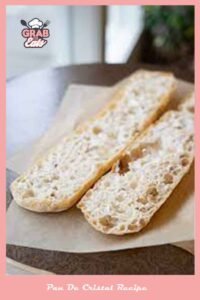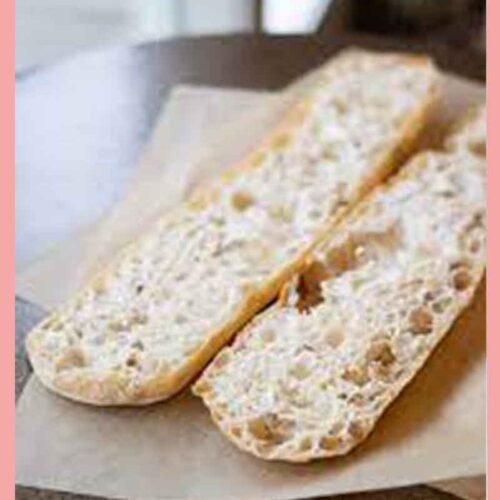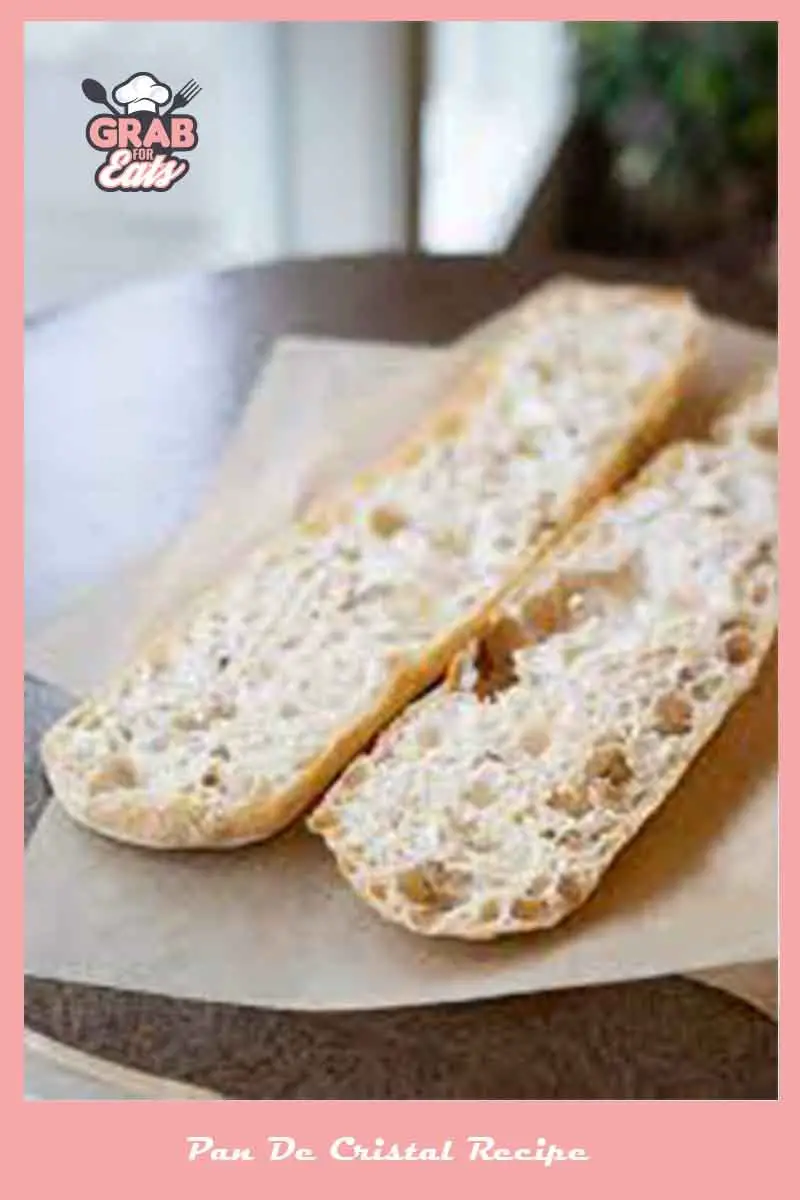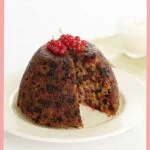If you’ve never tasted Pan de Cristal, or “Glass Bread,” you’re in for a real treat. Known for its light and airy texture with a crispy crust, this Spanish bread has been gaining popularity worldwide. Whether you’ve tried it at a Spanish restaurant or heard about it from a friend, making Pan de Cristal at home is easier than you might think! In this blog post, we’ll walk you through the process of making this delicious bread, dive into its history, and give you helpful tips to ensure your first attempt is a success.
Let’s get started with this Pan de Cristal recipe that will have you baking bread like a pro!

What is Pan De Cristal? A Brief History
Pan de Cristal is a traditional Spanish bread with a unique, light, and crispy texture. Its name translates to “Glass Bread,” which perfectly describes the thin, crispy crust and airy interior that almost seems to “shatter” when you break it. This bread originated in Spain, particularly in the region of Catalonia, where it’s a popular accompaniment to tapas and other Spanish dishes. It’s typically served with a drizzle of olive oil and a sprinkle of sea salt, allowing its delicate flavor to shine through.
Although it may take some time and patience to perfect, Pan de Cristal has become beloved worldwide due to its irresistibly crispy crust and soft, holey crumb. The process of making this bread is a little more intricate than your average loaf, but the result is totally worth it. Once you get the hang of it, you’ll be able to impress your friends and family with this show-stopping bread!
What Flour Should You Use for Pan De Cristal Recipe?
To create the perfect dough for Pan de Cristal, choosing the right flour is key. The two main flours you’ll want to consider are sturdy flour and Manitoba flour.
Sturdy Flour vs. Manitoba Flour
Both sturdy flour and Manitoba flour are types of high-protein flour, which are essential for bread recipes that require a strong, stretchy dough. These types of flour give the bread structure and elasticity, which helps the dough rise properly and achieve that light and airy crumb that Pan de Cristal is known for.
- Manitoba Flour: This is a type of high-gluten flour that’s known for its ability to hold large amounts of water and support long fermentation times. It’s often used in breads like Pan de Cristal because it helps create a light, open crumb.
- Sturdy Flour: Similar to Manitoba flour, sturdy flour is also a high-protein flour that works well in bread recipes that need structure. It’s a great alternative if you don’t have Manitoba flour on hand.
Both flours are great choices for this Pan de Cristal recipe as they provide the necessary strength to support the high hydration dough, leading to a beautifully airy loaf.
Pan De Cristal Recipe Ingredients
Here’s what you’ll need to make this amazing Pan de Cristal recipe:
Sturdy Flour or Manitoba Flour (400g) – Flour is the backbone of any bread recipe, and for Pan de Cristal, choosing the right type is essential. Both sturdy flour and Manitoba flour are high-protein, high-gluten flours, which provide the structure and elasticity needed to create the light, open crumb characteristic of this bread. These flours help the dough hold large amounts of water, allowing it to rise beautifully while maintaining the airiness that makes Pan de Cristal so special. If you can’t find Manitoba flour, sturdy flour is a great substitute, as it offers similar properties. The result? A soft, delicate interior with a crispy exterior.
Water (400 ml) – Water is the other key component in making bread dough, and for Pan de Cristal, you’ll need a significant amount of it to achieve the bread’s signature texture. The dough in this recipe is highly hydrated, which contributes to its lightness and the characteristic holes inside. The water helps dissolve the flour and yeast, creating a sticky dough that requires careful handling to maintain its structure. Make sure your water is at room temperature to allow for optimal yeast activation.
Dry Yeast (1.7g) – Yeast is the secret to making bread rise. Dry yeast is typically used for recipes like this one because it’s easy to handle and store. Yeast feeds on the sugars in the flour and produces gas, which causes the dough to rise and gives the bread its airy texture. When added to the dough, dry yeast helps create the characteristic light and fluffy crumb of Pan de Cristal, as well as contributing to the flavor development through fermentation.
Olive Oil (10 g) – Olive oil isn’t just for drizzling over the bread—it’s an important ingredient in creating a soft, smooth dough. The oil helps to enrich the texture of the bread, making it slightly more tender and adding a bit of flavor that pairs perfectly with the bread’s crisp crust. Additionally, olive oil helps maintain the moisture in the dough, ensuring that your Pan de Cristal will have the right balance of crispness on the outside and softness on the inside.
Salt (To Taste) – Salt is a vital component in any bread recipe, and it plays several important roles in Pan de Cristal. Not only does it enhance the flavor of the bread, but it also helps regulate the fermentation process, strengthening the gluten network and ensuring that the dough doesn’t rise too quickly or too slowly. It’s important to use salt sparingly and to dissolve it in water before adding it to the dough to ensure even distribution.
With these ingredients, you’re all set to make Pan de Cristal! Each component works together to produce that irresistible combination of a crispy crust and an airy, hole-filled interior. Follow the recipe closely, and you’ll be on your way to baking this classic Spanish bread in no time!
How to Make Pan De Cristal: Step-by-Step Instructions
Making Pan de Cristal requires a bit of time and patience, but with these simple steps, you’ll be well on your way to enjoying freshly baked bread. Follow this Pan de Cristal recipe carefully, and you’ll be rewarded with a perfect, crispy loaf!
Day 1: Prepare the Dough
- Mix the Flour and Water: In a large mixing bowl, combine the flour and water. Stir until fully incorporated, then let it rest for 15 minutes. This process is called autolyse, and it helps hydrate the flour.
- Add the Yeast: Sprinkle the dry yeast over the dough and mix it in gently. Start kneading the dough, but don’t knead too hard—just enough to start developing the gluten.
- Add the Salt: Dissolve the salt in a small amount of water (about 15g) and add it to the dough. Continue kneading until the dough starts to become smooth and elastic.
- Add More Water Gradually: Gradually add the remaining water in small amounts (around 355g total) while kneading the dough. This will help achieve the high hydration level needed for Pan de Cristal’s airy texture.
- Rest the Dough: Cover the dough with a damp towel or plastic wrap and let it rest for about 2 hours at room temperature.
- Cold Fermentation: After the initial rise, place the dough in the fridge for 12–14 hours (around 39°F/4°C). This slow fermentation helps improve the flavor and texture of the bread.
Day 2: Shape and Bake the Bread
- Shape the Dough: After the dough has rested, take it out of the fridge and let it warm up for an hour at room temperature. On a floured surface, gently divide the dough into two equal portions.
- Prepare the Baking Tray: Line a baking tray with parchment paper and sprinkle a little flour over it. Carefully transfer the dough onto the tray and dust with more flour to prevent sticking.
- Let the Dough Rise: Cover the dough with a cotton cloth and let it rise for 2 hours at room temperature, ideally at 78°F/25.5°C.
- Preheat the Oven: While the dough rises, preheat your oven to 482°F (250°C). If you have a baking stone or perforated tray, place it in the oven to help create a crispy crust.
- Bake the Bread: Once the dough has risen, place it in the preheated oven. After the first 8 minutes, reduce the temperature to 464°F (240°C) and bake for an additional 10 minutes. For an extra crispy crust, lower the temperature to 446°F (230°C) and bake for another 3–5 minutes.
- Cool the Bread: Once baked, remove the bread from the oven and let it cool on a wire rack. Slice and enjoy!
Utensils You’ll Need for This Pan De Cristal Recipe
o make this Pan de Cristal recipe, you’ll need the following utensils:
- Mixing bowls for combining the ingredients
- Metal scraper for dividing the dough
- Baking tray or perforated steel plate for baking
- Parchment paper to line the tray
- Cotton cloth for covering the dough while it rises
- Baking stone (optional) for an extra crispy crust
- Wire rack to cool the bread after baking
Best Dishes to Serve with Pan De Cristal
Pan de Cristal is a wonderfully versatile bread that pairs perfectly with a variety of dishes. Here are some great ideas for what to serve with it:
- Tapas: Pair it with traditional Spanish tapas such as cured meats (like jamón serrano), olives, and manchego cheese.
- Olive Oil and Salt: For a simple, classic option, drizzle it with some good-quality olive oil and sprinkle with sea salt.
- Soups and Stews: The crisp texture of Pan de Cristal makes it an ideal choice for dipping into rich, flavorful soups and stews.
- Grilled Vegetables: Serve it alongside grilled vegetables like peppers, tomatoes, and zucchini for a light yet filling meal.
Special Occasions to Enjoy Pan De Cristal
This Pan de Cristal recipe is perfect for a variety of occasions:
- Holiday Meals: Serve it as part of your festive meal at Christmas, Easter, or other holidays.
- Weekend Brunches: Make it for a special weekend brunch with family or friends.
- Dinner Parties: Impress guests with freshly baked bread at your next dinner party.

The Simple and Ultimate Pan De Cristal Recipe
Equipment
- Mixing bowls
- Metal scraper
- Baking tray
- Parchment Paper
- Cotton cloth
- Baking stone (optional)
- Wire rack
Ingredients
- 400 g Sturdy flour or Manitoba flour
- 400 ml water
- 1.7 g dry yeast
- 10 g olive oil
- salt (to taste)
Instructions
Day 1: Prepare the Dough
- Mix the Flour and Water: In a large mixing bowl, combine the flour and water. Stir until fully incorporated, then let it rest for 15 minutes. This process is called autolyze, and it helps hydrate the flour.
- Add the Yeast: Sprinkle the dry yeast over the dough and mix it in gently. Start kneading the dough, but don't knead too hard—just enough to start developing the gluten.
- Add the Salt: Dissolve the salt in a small amount of water (about 15g) and add it to the dough. Continue kneading until the dough starts to become smooth and elastic.
- Add More Water Gradually: Gradually add the remaining water in small amounts (around 355g total) while kneading the dough. This will help achieve the high hydration level needed for Pan de Cristal’s airy texture.
- Rest the Dough: Cover the dough with a damp towel or plastic wrap and let it rest for about 2hours at room temperature.
- Cold Fermentation: After the initial rise, place the dough in the fridge for 12–14 hours (around 39°F/4°C). This slow fermentation helps improve the flavor and texture of the bread
Day 2: Shape and Bake the Bread
- Shape the Dough: After the dough has rested, take it out of the fridge and let it warm up for an hour at room temperature. On a floured surface, gently divide the dough into two equal portions.
- Prepare the Baking Tray: Line a baking tray with parchment paper and sprinkle a little flour over it. Carefully transfer the dough onto the tray and dust with more flour to prevent sticking.
- Let the Dough Rise: Cover the dough with a cotton cloth and let it rise for 2 hours at room temperature, ideally at 78°F/25.5°C.
- Preheat the Oven: While the dough rises, preheat your oven to 482°F (250°C). If you have a baking stone or perforated tray, place it in the oven to help create a crispy crust.
- Bake the Bread: Once the dough has risen, place it in the preheated oven. After the first 8minutes, reduce the temperature to 464°F (240°C) and bake for an additional 10minutes. For an extra crispy crust, lower the temperature to 446°F (230°C) and bake for another 3–5 minutes.
- Cool the Bread: Once baked, remove the bread from the oven and let it cool on a wire rack. Slice and enjoy!
Tips
- Don’t Rush the Dough: Allow plenty of time for the dough to rest and ferment. The longer the dough ferments, the better the flavor and texture will be.
- Use the Right Flour: Make sure to use sturdy or Manitoba flour to get the perfect structure and texture for the bread.
- Preheat the Oven: A well-preheated oven ensures a crispy crust, so don’t skip this step!
- Enjoy Fresh: Pan de Cristal is best enjoyed on the same day it’s baked. If you have leftovers, store them in a paper bag to maintain its crispness.
Nutrition
Conclusion: Enjoy Your Homemade Pan De Cristal
Making Pan de Cristal at home might take some time and patience, but the results are absolutely worth it. The crispy crust and soft, airy interior are simply irresistible. Whether you’re serving it with tapas, soups, or just enjoying it on its own with a drizzle of olive oil, this Pan de Cristal recipe is sure to impress. Happy baking!




